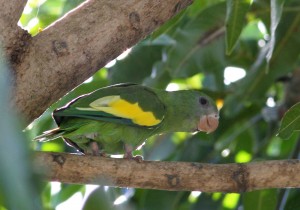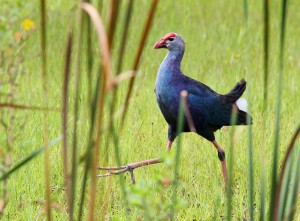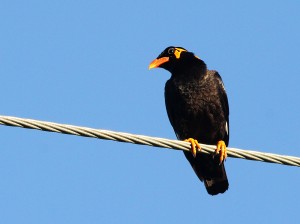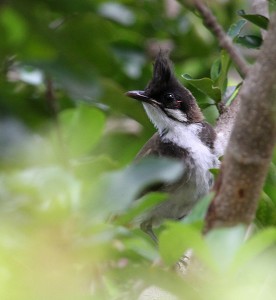American Parakeets: Changing Tunes?

A couple of years ago I wrote about the importance of recording exotic birds in the places where they’ve been introduced, not just in their native ranges. Recording exotics is important for several reasons, but I put particular emphasis on this one:
Most birds with learned songs are apparently genetically predisposed to pick out the sounds of their own species from the chorus and imitate those, but if they’re first- or second-generation immigrants in an avian Babel, they might not have many, or any, of their own species to learn from. Might the scarcity of conspecific tutors restrict the repertoire size of immigrants? Might it force them to innovate or imitate other species? We don’t really know.
Now, preliminary evidence is pointing toward an answer, and that answer appears to be “yes.” In at least one species, some individuals sound different in their adopted country than do their ancestors back in the homeland.
Yellow-chevroned and White-winged Parakeets in Florida
These two small South American parakeets are closely related — in fact, they were until recently considered a single species, “Canary-winged Parakeet.” They look and sound quite similar, and where both species occur in south Florida, they sometimes hybridize. As a result, their status and distribution in Florida have been somewhat difficult to tease apart. I’ve heard from a couple of sources that White-winged used to be the more common of the two species in south Florida, but has declined in recent years, while Yellow-chevroned has increased.
The vocal differences between these two species have not been well described. Like all parrots, White-winged and Yellow-chevroned Parakeets give complex and varied vocalizations. One common sound from both species is a mellow, musical, multi-syllabic chirp, which averages slightly higher-pitched in Yellow-chevroned:
The more distinctive sound of these species is a noisy chatter. In its native range in South America, the chatter of White-winged is significantly slower, with each individual note clearly audible. The chatter of Yellow-chevroned is much faster, with the notes run together into a continuous churr:
Here’s the rub. In south Florida, at least some of the Yellow-chevroned Parakeets sound quite a bit like White-wingeds:
The differences are subtle, and there are a lot of birds in this recording (it was a roost of over 200 individuals), but the sounds here seem consistently closer to “classic” White-winged than to “classic” Yellow-chevroned, in both the pitch of the chirps and the speed of the chatters. The majority of sounds are intermediate. There might have been a couple of White-wingeds hidden in the flock, but the observers, Andrew Spencer and Carlos Sanchez, didn’t see any White-wingeds or hybrids — only apparently pure Yellow-chevroneds.
It might be that the Yellow-chevroned Parakeets of south Florida have come into contact with White-winged Parakeets and learned some of their vocalizations. I wouldn’t be surprised if parakeets in a flock gradually changed calls to be more like those of their flockmates; similar behavior has been documented in a number of species of cardueline finches. There may also be some mixed ancestry involved, even if none was evident in plumage patterns. It’s hard to say.
What’s clear is that there’s no guarantee that feral exotic birds will sound exactly like their wild ancestors. That’s why it’s important to record them where you find them. Exotics are everywhere: lovebirds in Phoenix, magpie-jays in San Diego, Rose-ringed Parakeets in Bakersfield, Nutmeg Mannikins in Pensacola. It’s time we started paying more attention to what they’re saying.




